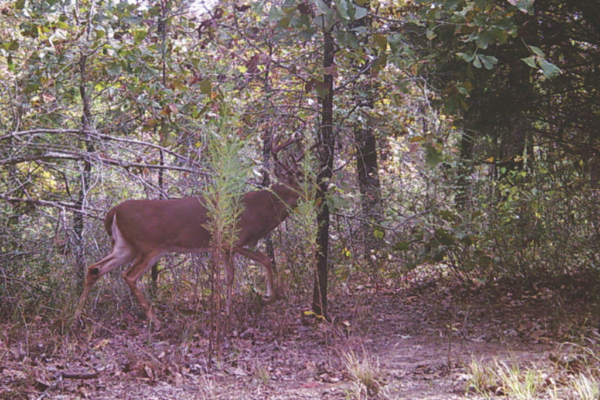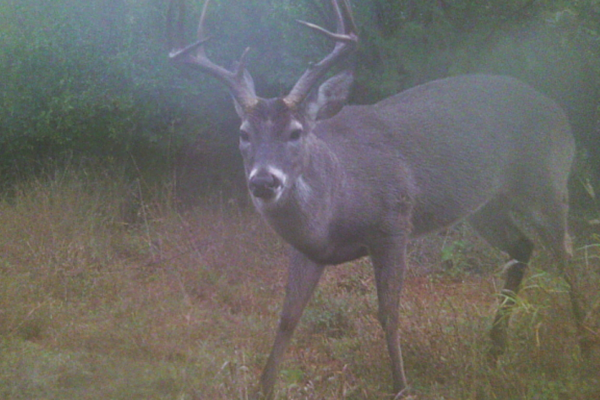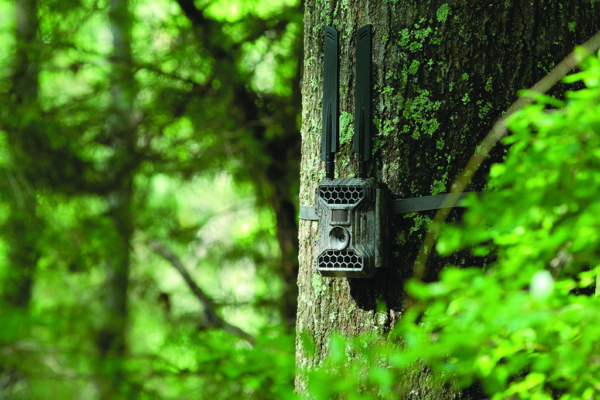Eye See You: Getting the Most out of Your Game Camera
By Matt Williams
It’s been said that you only get out of something what you put into it. And so it goes with game camera use. The studious hunter who does a little homework and follows a strategic game plan when hanging game cameras is almost certain to achieve much better success than a guy who straps one around a random tree and hopes for the best.
Translation: Location is everything.
Greg Bludau of College Station knows a thing or two about deer hunting with a game camera. Bludau is a 31-year-old archer with a long line of whopper bucks to his credit. He said 2017 was a particularly costly season in terms of taxidermy bills.
Bludau arrowed a trio of trophy whitetails and a nilgai cow. He took two of the bucks on public land drawn hunts at the Gus Engling WMA in eastern Texas and the Chaparral WMA in South Texas, both managed by the Texas Parks and Wildlife Department. He killed the third buck on a low fence lease he helps oversee in Milam County.
Though none of the bucks were record book caliber, two of them—the Engling WMA buck and private lands buck—cracked the Texas Big Game Awards Program minimums for their regions. Had it not been for a busted brow tine, the handsome 10 pointer he collected at “The Chap” would have been knocking at the door of the 140-minimum required for TBGA typicals in Region 8, as well. Killing one TBGA buck with a bow on public land is a big-league accomplishment. Pulling it off multiple times in the same season is nothing short of remarkable.
A consummate hunter, Bludau said he owes a majority of his success to his game cameras. He says game cameras help him zero-in on productive hunting spots. Moreover, they sometimes show him the quality of bucks on the prowl, and offer solid hints as to when deer show up, often before he sits in a stand for the first time. It’s a confidence thing that makes him hunt longer and smarter.
“I had pictures of each one of those deer before I killed them,” Bludau said. “Cameras are my eyes in the field day and night, 24/7. The more cameras you have, the more eyes you have and the more area you can cover. Whenever I go scouting, I’ll always have backpack full of cameras.”
If it sounds like Bludau takes his picture taking seriously, it’s because he does.
“I may spend as much time or more overall trying to capture a photo of a specific buck more than I do actually hunting that specific buck,” he said. “Finding fresh sign, setting up a camera and capturing a photo of a mature buck is a sense of accomplishment in itself. It’s half the success, especially for a bowhunter on public land.”
Location, location, location
As earlier mentioned, location is essential when hanging game cameras. Think of it like bass fishing on a great big lake. You might get a bite casting a worm into the wild blue yonder, but the odds will be much better if you drag it around a high percentage area created by a point, channel swing, or underwater brush pile. Bludau said the same is true with game camera placement. He always tries to strategically place his cameras at locations where he thinks the odds of deer triggering the shutter are the very best.
A seasonal thing
Bludau says the best places to hang game cameras vary with the time of year, what the deer are doing, and what he is hoping to accomplish:
Pre-Season and Early Season
In late summer and early fall, he’ll spend time scouting for bedding areas and pinpointing obvious entrance and exit points. Placing cameras in relation to those passages is a good way to find out what’s coming and going. Pre-scouting and performing observatory sits around fields or pastures also can reveal potential sweet spots for hanging a camera or two, Bludau said.
“Ideally, I like find a good tree I can get in that offers a 360-degree view of the field,” he said. “I’ll identify places where deer or entering or exiting the field. There could be several trails, but they will usually have one or two spots where they really like to enter or exit. A game camera placed at those locations might show you other deer you didn’t get a visual on.”
Behavior patterns usually start to change around the start of archery season, particularly in eastern Texas, where visible signs of early rutting activity start showing up long before Halloween. One of Bludau’s favorite places to hang game cameras during the pre-rut is in relation to ground scrapes that appear to get plenty of traffic.
“Scrapes don’t just attract the buck that made it; they also attract other bucks,” he said. “Bucks are inherently nosey and they like to get into one another’s business. They’ll scent check another buck’s scrape out of curiosity. It’s not uncommon to get pictures of multiple bucks around the same scrape.”
Late Season and Post Season
“If it’s late in the season I’m going concentrate more on food sources and well-beaten trails more than anything else,” he said. “To me, fresh sign late in the year is going to be tracks and really fresh droppings. If you’re running corn feeders on private property, that’s a good bet late in the year or after the season closes. It’s a good way to learn which bucks made it through the season, or if any new ones may have moved into the area.”
A bird’s eye view
Finding good places to hang cameras on an unfamiliar piece of property presents some obvious challenges, especially when you have limited time to scout. Bludau says satellite imagery available via Google Earth is a great time saver. Aerial scouting will help you home in on potential hotspots before you ever leave home.
“I use it a lot,” he said. “I’ll use it to find potential bedding areas and natural pinch points; places where the deer don’t have any other option except to travel right in front of me. If there are tracks and fresh droppings in there during the pre-season, you can bet there will be scrapes in there later on. Natural funnels are great places to check out with a game camera.”






